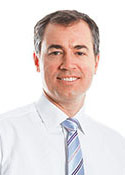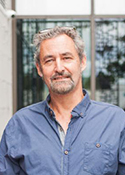Stirling
Margin: Liberal 9.2%
Region: Northern Perth, Western Australia
In a nutshell: Once a tight marginal seat, Stirling has moved heavily to the Liberals as part of a statewide trend over the past decade.
Candidates in ballot paper order

|
KIM MUBARAK ALISON L ROWE MICHAEL KEENAN KEVIN HOST TOM WEBSTER ROBERT PEARSON |
Created in 1955 to accommodate Perth’s post-war northern suburban expansion, Stirling was long a marginal seat until the current Liberal member, Michael Keenan, established an ascendancy after winning it from Labor in 2004. Originally extending all the way inland to Guildford, the electorate assumed roughly assumed its current dimensions following a redistribution in 1969. It currently encompasses the coast from northern Scarborough north to Watermans Bay, and extends inland to Dianella in Perth’s inner north. Demographically, the coastal suburbs are older, wealthier, more affluent, and generally more favourable to the Liberals. Balga in the electorate’s north-east is proverbial for its low socio-economic status, while neighbouring Mirrabooka is home to large Arabic and Vietnamese populations. Further south, Dianella and Yokine are wealthier, and form the hub of Perth’s Jewish community. The redistribution has added 8700 voters in eastern Dianella from Perth, and trimmed it in two places along the southern boundary: at Innaloo in the west, where 9500 voters go to Curtin, and Coolbinia and Menora in the east, where 2800 voters go to Perth. The changes slightly reduce the Liberal margin, from 10.3% to 9.2%.
For all but one term from its creation until 1972, Stirling was held for Labor by Harry Webb, who narrowly lost the seat in 1958 and just as narrowly regained it in 1961. The tide to Labor at the 1969 election enabled Webb to retain the seat despite its being made notionally Liberal by redistribution, but he was defeated when Western Australia bucked the national trend in 1972. Its members since then have been Ian Viner, a Fraser government Aboriginal Affairs Minister who held on by 12 votes in 1974; Ron Edwards, who defeated Viner in 1983 and narrowly retained it at three further elections; Eoin Cameron, a promiment radio broadcaster who unseated Edwards in 1993; and Jann MacFarlane, who recovered the seat for Labor in 1998 and retained it in 2001, reflecting Labor’s strong performance in Western Australia under Kim Beazley’s leadership.
The seat changed hands for the third time in five elections in 2004, when a 3.6% swing accounted for MacFarlane’s margin of 1.6%. The victorious Liberal candidate was Michael Keenan, a former adviser to Amanda Vanstone and Alexander Downer who had been drafted to the seat after the original Liberal candidate, Paul Afkos, withdrew under a cloud. Keenan survived a determined Labor challenge at the 2007 election from Peter Tinley, a former SAS officer Peter Tinley who is now a front-bencher in the state Opposition, who was only able to knock 0.7% off the existing 2.0% margin. The Liberals’ mounting strength in Western Australia was further emphasised by successive swings of 4.3% and 4.8% in 2010 and 2013.
After the 2007 election defeat, Keenan won promotion to the front bench as Shadow Assistant Treasurer and Shadow Minister for Superannuation and Corporate Governance. His alignment with Malcolm Turnbull then appeared to be reflected in his career trajectory, as he gained the shadow cabinet post of employment and workplace relations when Turnbull became leader in September 2008, only to return to the junior shadow ministry in justice and customs when Tony Abbott deposed him in December 2009. However, Keenan’s loyalties during the September 2015 leadership challenge were unknown, and his outer ministry position as Justice Minister was left undisturbed afterwards.
Analysis by William Bowe. Read William’s blog, The Poll Bludger.


